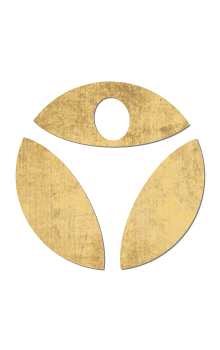What is the Cow Face Pose In Yoga? Pose Guide, Practical Tips and Modifications For Beginners.
- Updated on: July 8, 2022
Purpose
Here are some of the reasons why Cow Face Pose is good for you:
- Deep hip and shoulder stretch
- Tones abdominals
- Stimulates blood circulation for digestive organs
- Stretches and strengthens back
- Opens and stretches chest
- Counters the effects of prolonged sitting
- Strengthens the core and spinal column
Pose Guide
In order to do Cow Face Pose correctly, here are the steps:

- Begin seated with your knees bent up toward the sky and your feet planted flat on the floor. Your arms can rest at your sides for support as needed.
- Slide your left foot under your right knee. Bring your left foot to rest along the outside of your right hip. Your foot will be resting on the outer edge. Your left knee will be on the ground pointing forward at the midline of your body.
- Slide your right leg toward the left to stack your right knee directly atop your left knee.
- Position your right foot along the outside of your left hip, resting it on the outer edge.
- Adjust your feet so that they are equidistant from your hips.
- Distribute your weight evenly between your hips.
- Engage your core and lengthen your spine.
- Raise your arm out to shoulder height in a “T” position with the palms facing forward.
- Lift your right arm toward the sky, bending the elbow and placing your palm flat against your upper back as if you were patting yourself on the back.
- Lower your left arm toward the ground, bending the elbow and placing the back of your palm against your middle back as if you were holding a bouquet of flowers behind your back.
- Bring the hands together at (or near) the midpoint between your shoulder blades, and curl your fingers around each other.
- Press the elbows toward the back of the room to open your chest. Flatten your shoulder blades against your back while drawing them down away from your ears.
- Stretch your ears away from your shoulders as you continue to lengthen your spine and engage your core.
- Keep your shoulders and your hips squared to the front. The spine should not be twisting, but will be erect and aligned.
- Keep your chin parallel to the ground.
- Repeat on the other side.
Practical Tips
Do This, Not That! Common mistakes beginners make in Cow Face Pose:


- Twisting the spine: Cow Face is not a twisting pose. The spine is meant to be tall and straight. Because this pose provides such a deep rotational stretch in the hips and shoulders, it can be difficult for many beginners to find the proper position to support the spine. The shoulders and the hips should both remain squared to the front of the mat. If you have tight hips and/or shoulders, you may need to modify the pose to maintain the correct alignment. See the modifications section below for modification options.
- Rounding the back and head forward to support the arms: It’s common to round the back and head forward in an attempt to support the arm position behind the body. This should be avoided as it places unnecessary tension and stress on the spine. Instead, lift the crown (top) of the head toward the sky. Take your shoulders back, opening your chest and flattening your back. If your shoulders are too tight to maintain the proper spinal alignment and arm position, you may need to modify the pose as you increase your flexibility and mobility. Check out the modifications section below to find helpful ways to modify Cow Face for your particular body


- Not keeping the knees stacked: Make sure you keep your knees stacking one directly over the other. This is the best way to ensure proper rotation through the hip joints and alignment through the lower body.
- Lifting one side of your glutes off the ground: Another common error is to allow your glutes to lean to one side, lifting one hip off the ground. This creates a misalignment in the spinal column and can lead to future chronic weakness and injury. Make sure you are fully connecting both hips into the ground while evenly distributing your weight between them.


- Sitting on the heels: Your hips should be squared, making even connection with the ground, in Cow Face. This ensures the proper alignment of the spine. Those with overly tight glutes, hips, legs or knees will sometimes make the mistake of sitting on one heel in an effort to approximate the pose. However, this creates an imbalance in the lower body and shifts the spine out of alignment, setting the stage for discomfort or injury. If you cannot keep your hips on the ground with your feet on either side of your hips, you may need to modify the pose. Modifying the pose can allow you to practice the pose in the safest and most effective way while you are developing the flexibility, mobility and strength needed for the full expression of the pose. See the section below for modification options.
Props and Modifications
You should consider a modification if you experience the following:
- Inability to stack the knees
- Inability to connect your hands behind your back
- Difficulty keeping the back and neck fully erect
- Discomfort or restriction in the hips limiting your ability to place the feet outside your hips


Inability to stack the knees:
- Try elevating your hips off the ground by sitting on a block or bolster. This decreases the angles of the folds in the joints making it more comfortable and possible to find the proper alignment in the legs.

- You can also try looping a strap around both your knees and tightening it just enough to provide some gentle tension to help hold your knees in place during the pose.
Inability to connect your hands behind your back:
- Initially, you may choose to focus your efforts on the lower body when practicing Cow Face. This can be a valid option for people who have excessive tightness or limitation in both the hips and the shoulders. In this case, you could find a much less intense position for the arms, such as holding opposite elbows behind your waist, bringing palms together at your chest, or even resting your arms at your sides. Then, when you’re ready, start focusing on the shoulder stretch by graduating the modifications below.
- Try bending your elbows at right angles instead of bringing your hands together behind your back. Your raised forearm will be parallel to the ground just over your head. Your lowered forearm will be parallel to the ground across the back of your waist.

- Alternatively, you can hold a strap or rolled towel in your hands behind your body. Grip the strap or towel in each hand, adjusting the distance between your hands to your level of flexibility. The palm of your upper hand will be facing toward your body, and the lower palm will be facing away from your body. Pull the strap in opposite directions as you open your chest.

Difficulty keeping the back and neck fully erect:
- Practicing Cow Face Pose with your back against a wall can be helpful. This gives you a tangible guide for understanding the position of your spine as you move through the pose. Keeping your shoulders and arms resting on the wall and your back and head resting against your arms lets you know you are aligned.
- If your arms are short or your shoulders are tight, you may just need a little extra space between your hands to maintain the upright spinal position. Try holding a strap or towel between your hands, adjusting the distance between your hands as much or as little as you need to keep your spine erect.
Discomfort or restriction in the hips limiting your ability to place the feet outside your hips:
- One way to modify Cow Face if you are unable to position your feet outside your hips is to practice the pose on one hip at a time. For this version, the bottom leg will be extended out in front of you with the knee and toes facing the sky. The top leg will be positioned as instructed above, with the knee resting over the bottom thigh and the foot resting on the ground outside the opposing hip. You can practice this version with your back against a wall for additional support as you increase the flexibility in your hips through consistent supported practice.

- Another option is to elevate your hips to decrease the intensity of the rotational stretches at each joint. Sitting on a block or bolster is a great way to do this. Adjust the height of the prop so you can find the proper alignment in your lower body.
- Bonus tip: Many beginners, and often men in particular, can find the hip opening stretch with the legs to be nearly impossible. One way to practice this pose while still receiving the shoulder opening benefits is to place your bottom torso into a kneeling position such as Hero Pose while still clasping your hands behind your back (most likely with a strap).

F. Common questions:
- When is Cow Face Pose contraindicated?
- Is Cow Face Pose a twisting pose?
- What if I can’t get my legs to do what they’re supposed to do?
- What if I can’t reach my hands behind my back?
- Is it okay to sit on my foot?
- When using a strap, does it make a difference how close the hands are to each other along the strap?
- When using a strap, does it matter which way my hands are holding the strap?
When is Cow Face Pose contraindicated?
- Acute hip injury, including sciatica
- Acute shoulder injury
- Acute knee, ankle, or leg injury
- Pregnancy – consult your healthcare provider
Is Cow Face Pose a twisting pose?
- No, the spine should remain aligned and straight during Cow Face Pose with the hips and shoulders squared forward.
What if I can’t get my legs to do what they’re supposed to do?
- This is a deep hip stretching pose. Those with tight hips may find it challenging or even impossible to get the legs into the correct position when first approaching Cow Face Pose. In this instance it is best to modify the pose. If this is you, see the section above to find a modification that will address your particular needs.
What if I can’t reach my hands behind my back?
- This is a deep shoulder stretching pose. Those with tight chest, shoulder and upper back muscles may find it challenging or even impossible to get the arms and hands into the full position when first approaching Cow Face. In this instance it is best to modify the pose. If this is you, see the section above to find a modification that will address your particular needs.
Is it okay to sit on my foot?
- No, sitting on your foot creates an imbalance in your spinal alignment which can set you up for future injury or discomfort. Your feet should be resting on the ground outside the opposite hips. Your feet will be connecting with the ground at the outer edges.
When using a strap, does it make a difference how close the hands are to each other along the strap?
- The difference between your hands only matters in reference to your own body’s flexibility. The closer your hands are together, the more intense the stretch, and, therefore, greater flexibility through your chest, back and shoulders is required.
When using a strap, does it matter which way my hands are holding the strap?
- For proper alignment and optimal comfort and safety, the lower hand will be holding the strap with the palm facing away from the body. The upper hand will be holding the strap with the palm facing toward the body.
Additional Resources for beginners
Recent Posts
Categories
Related Articles
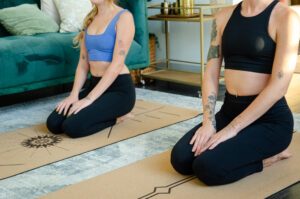
Breathing technique to improve your yoga practice
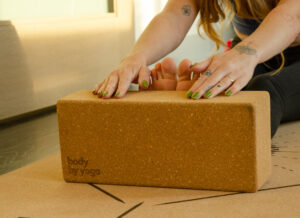
Benefits of yoga before bed
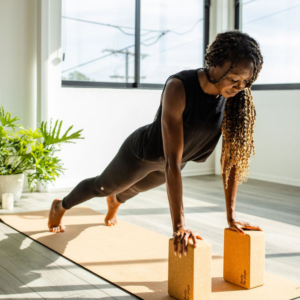
Taking the next step to more challenging yoga
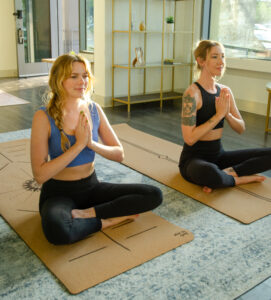
Hatha vs Power yoga
Related Articles
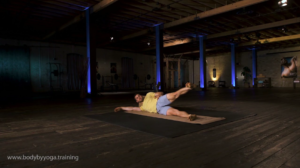
Stretching and Strengthening your hips
In this workout we start slow to warm up your hips. Utilizing low impact workouts like this can be important for beginners and yoga veterans

Hatha vs Power yoga
We’ve created our own unique style of slow burn power yoga that combines Hatha yoga, power yoga, bodyweight exercises and physical therapy. This way in
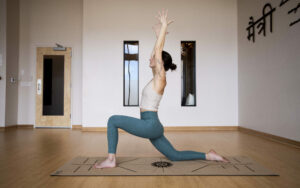
The importance of maintaining correct alignment
Everything in your body is connected, so when one muscle isnt aligned properly it can be a slippery slope to injury. Building a solid foundation
